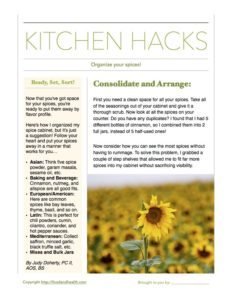Kitchen Hack: Herbs and Spices
Are you still alphabetizing your dried herbs and spices? Or did you try to separate herbs and spices into two sections? Or are they all just jumbled up, starting with the most popular in the front and the least used in the back? Do you just want to have an easier way to organize your spices? If so, you're in luck! I just came up with a great way to organize my spice cabinet and now I want to share it with you.The key is to organize them by flavor profile.That's right!Here's a great way to organize your herbs and spices so that you can find and use them quickly.Step #1: ConsolidateTake all of the seasonings out of your cabinet and give it a thorough scrub. Now look at all the spices on your counter. Do you have any duplicates?I found that I had 5 different bottles of cinnamon, so I combined them into 2 full jars, instead of 5 half-used ones!Step #2: Arrange Your SpaceHow can you see the most spices without having to rummage?I grabbed a couple of step shelves that allowed me to fit far more spices into my cabinet without sacrificing visibility. Here's a link to an expandable set of shelves on Amazon.com.Step #3: Decide on Flavor ProfilesNow that you've got space for your spices, you're ready to put them away by flavor profile.Here's how I organized my spice cabinet, but it's just a suggestion! Follow your heart and put your spices away in a manner that works for you.Oh, and I might list the same seasoning in several categories here and that's okay because you might not use all of the categories I'm outlining! Just use this as a guide so you can find and use your seasonings according to the way you cook!Asian: Put all of the spices for curry, stiry fry dishes, and Indian dishes in one area of your cabinet. This will probably mean lemon grass, oriental mustard, five spice powder, garam masala, sesame oil, tandoori powder, coconut milk powder, fish sauce, and more. Latin: Place all of your latin seasonings in one area. This might include all kinds of chili powders, oregano, cumin, cilantro, coriander, and hot pepper sauces.Baking and Beverage: This is usually common spices used in baking like cinnamon, cloves, ginger, apple pie spice, pumpkin pie spice, cinnamon sticks, etc. They're great in teas and other drinks too!Mediterranean: Arrange oregano, saffron, minced garlic, garlic powder, black truffle salt or truffle oil, rosemary, capers, basil, bay leaves, fleur de sel, and tomato powder together in one section of your spice cabinet.European/American: This category is full of the most common spices. I often use them for roasting meats and vegetables. This section of your spice rack could include bay leaves, thyme, rosemary, oregano, Italian seasoning, marjoram, basil, garlic powder, etc.Mixes and Bulk Jars: This is the place for mixed seasonings like Old Bay or for large containers of garlic powder, black pepper, and salt.And there you have it! A new way to make it easier to prepare healthful, flavorful meals at home! For a printable reference you can post on your fridge, don't miss this new PDF handout. Have I mentioned that members get more?For a closer look at the flavor profile for a bunch of popular spices, don't miss the post Spice and Flavor: What You Need to Know, which comes with a fun handout as well.Finally, last but not least, there are tons of helpful kitchen resources in the Nutrition Education Store. Here are a few of my favorites...[shopify embed_type="product" shop="nutrition-education-store.myshopify.com" product_handle="vegetable-poster-slicing-chopping-and-cooking-guide" show="all"][shopify embed_type="product" shop="nutrition-education-store.myshopify.com" product_handle="guide-to-spectacular-and-professional-plate-presentation-course-on-dvd" show="all"][shopify embed_type="product" shop="nutrition-education-store.myshopify.com" product_handle="guide-to-fats-and-oils-poster-18-x-24" show="all"]
Have I mentioned that members get more?For a closer look at the flavor profile for a bunch of popular spices, don't miss the post Spice and Flavor: What You Need to Know, which comes with a fun handout as well.Finally, last but not least, there are tons of helpful kitchen resources in the Nutrition Education Store. Here are a few of my favorites...[shopify embed_type="product" shop="nutrition-education-store.myshopify.com" product_handle="vegetable-poster-slicing-chopping-and-cooking-guide" show="all"][shopify embed_type="product" shop="nutrition-education-store.myshopify.com" product_handle="guide-to-spectacular-and-professional-plate-presentation-course-on-dvd" show="all"][shopify embed_type="product" shop="nutrition-education-store.myshopify.com" product_handle="guide-to-fats-and-oils-poster-18-x-24" show="all"]